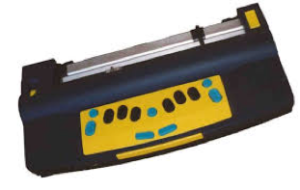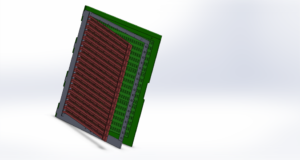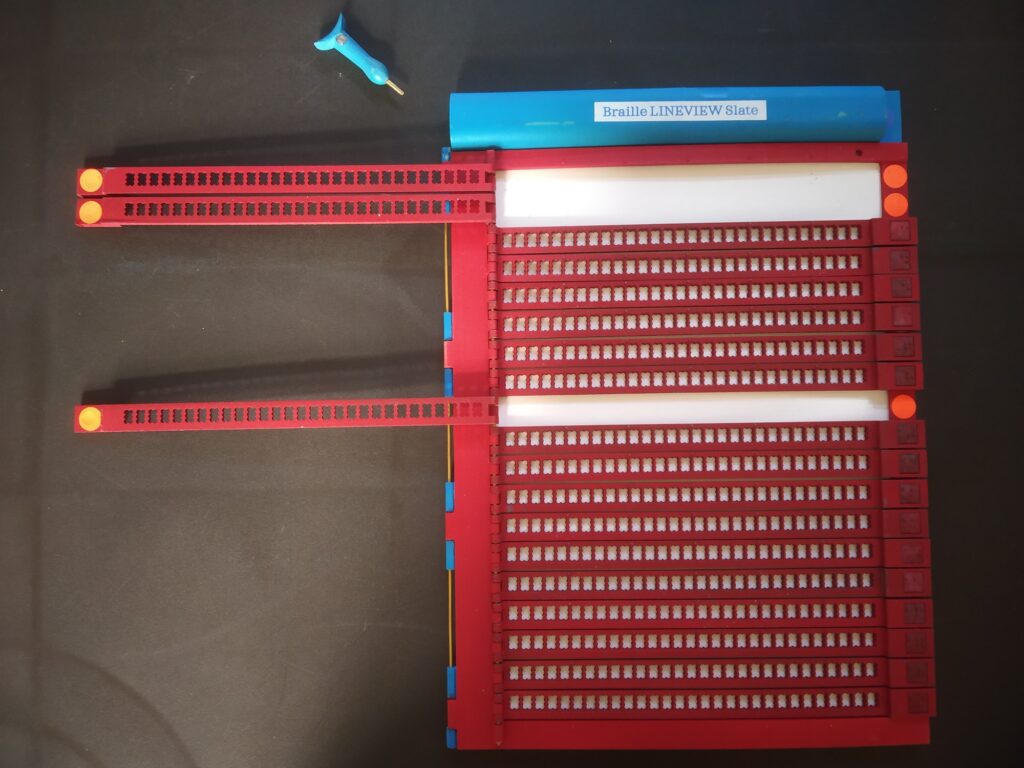Braille LINEVIEW™ Slate
Braille LINEVIEW™ Slate is a Direct Braille Slate (Patent published under PCT) with slate-like experience, that allows locating, reading, and writing of the Braille cells anywhere on the braille page easily, thus making it suitable for back-referring and back-editing without removing and flipping the page – a mandatory requirement for Maths.
Braille LINEVIEW™ Slate received Research Grant from Department of Science & Industrial Research (DSIR) Government of India – in collaboration with IIT Kanpur. This is in “prototype” stage.
Present Braille Slates and Issues
Braille LINEVIEW™ Slate – Features and Benefits
Braille LINEVIEW™ Slate – State of Development
Present Braille Slates and Issues
Traditional Braille Slate
A traditional braille slate allows the visually disabled user to make dots by pressing a round pin-pointed stylus on a paper, aided by grooved guides depicting each braille cell. However, to read the same, the user needs to remove the page, reverse it, and feel raised dots formed in each cell by pressing of the paper by the stylus. The traditional braille approach, unfortunately, demands the visually disabled user to write from right-to-left in a mirror image format, so that the mirror image (in intended script) of each braille cell is created on the reverse side of the page. This process of writing using the traditional braille slate is called ‘Indirect Braille writing’. The traditional braille slate is shown in figure below.

Disadvantages of ‘Indirect Braille writing’
The major disadvantage is that visually disabled users have to learn braille twice – one for reading and another (a mirror image) for writing. Learning braille twice is confusing as well as cumbersome, especially for little children who have just started learning the braille. Furthermore, in a traditional braille slate, if a dot is wrongly pressed, then locating and marking the braille cell that was created wrong is rather complicated (since locating the wrongly pressed dot has to be done on reverse side of the paper that has no row/column grid to guide the visually disabled user). This “can’t go wrong” condition causes an added anxiety in the visually disabled user’s mind while writing on the traditional braille slate.
Another disadvantage of ‘Indirect Braille writing’ is that the braille users face extreme difficulty in all those writing activities that need back-referring (the need to refer what the braille user has written in previous line on the page) and back-editing (the need to add number or mark, like carry or cross, to what is written in previous lines on the page). The back-referring and back-editing is needed most while solving Math problems whether arithmetic (simple addition, subtraction, multiplication, division, or square-root), algebra (solving a simple equation or simply placing values in variables), and the like. The difficulty is that, every time a braille slate user needs to refer to or edit what the user has written previously on the page, the user has to take the paper out of the braille slate, flip the paper, locate the row and column on the reverse side of the paper, read, and again flip the paper, put it back onto the braille slate, re-align the paper perfectly as was earlier (which is highly error-prone when done by a visually disabled user), and then proceed.
Direct Braille Slates in the market
There are mainly 3 products in the market that allow “Direct Braille” writing.
Electronic Brailler
 The Electronic Brailler is the most popular “Direct Braille” writer and it is like a small typewriter. It has a keypad that includes eight keys for each eight-dot braille cell, a space key, a backspace key, and a newline key.
The Electronic Brailler is the most popular “Direct Braille” writer and it is like a small typewriter. It has a keypad that includes eight keys for each eight-dot braille cell, a space key, a backspace key, and a newline key.
Major limitation with Electronic Brailler is that, it is bulky, heavy, and expensive. Moreover, it is not suitable for back-referring and back-editing that is essential for Maths.
Hawk’s Braille Slate
 Hawk’s Braille Slate constitutes a full-page size base plate with a punching clamp at the top to grip and align the paper. For writing, it has a 6-row wide plate-pair that can be placed at 4 pre-defined slots on the base plate. The top plate of plate-pair, kept above the paper, has the guides depicting each braille cell, while the bottom plate, attached to top plate with a hinge and kept below the paper, has hemispherical pins corresponding to each braille dot. A hollow-tip stylus is provided to create bumps in paper instead of depressions.
Hawk’s Braille Slate constitutes a full-page size base plate with a punching clamp at the top to grip and align the paper. For writing, it has a 6-row wide plate-pair that can be placed at 4 pre-defined slots on the base plate. The top plate of plate-pair, kept above the paper, has the guides depicting each braille cell, while the bottom plate, attached to top plate with a hinge and kept below the paper, has hemispherical pins corresponding to each braille dot. A hollow-tip stylus is provided to create bumps in paper instead of depressions.
The major limitation with Hawk’s Braille Slate is that, it is not quite suitable for back-referring and back-editing. Moreover, the motion of plate-pair is jerky and tends to tear the page.
Braille Upwriter
 Braille Upwriter is a small handy typewriter roller like device, that allows writing one row at a time. The paper passes through a roller, which has hemispherical pins corresponding to each braille dot, while the top of the roller has the guides depicting each braille cell. A concave-tip stylus is provided to create bumps in paper.
Braille Upwriter is a small handy typewriter roller like device, that allows writing one row at a time. The paper passes through a roller, which has hemispherical pins corresponding to each braille dot, while the top of the roller has the guides depicting each braille cell. A concave-tip stylus is provided to create bumps in paper.
The major limitation with Braille Upwriter is that, it is also not suitable for back-referring and back-editing. Moreover, it doesn’t provide a slate-like experience that the braille users are used to.
Braille LINEVIEW™ Slate – Features and Benefits
The Design
The objective was to design a Direct Braille Slate with slate-like experience, that allows locating, reading, and writing of the Braille cells anywhere on the braille page easily, thus making it suitable for back-referring and back-editing without removing and flipping the page.
Braille LINEVIEW™ Slate (Patent published under PCT), as shown below, includes a slate base, a slate frame, and a line guide unit – all fixedly coupled.
The slate base (depicted in green) is the solid back part of the slate. It consists of a matrix of rows and columns of hemispherical pins over it arranged in 6-dot or 8-dot braille grid (called braille cell). Each row corresponds to a braille text line on the page and contains a series of braille cells. The hemispherical pins are designed such as to create embossed bump impressions on a braille paper when the braille paper is pressed using a hollow or concave tip “Upwrite Dot stylus” against any of the pins.

The slate frame (depicted in grey) is frame like structure that is hinged with the slate base on one side and is open at the other side for inserting the braille paper in between the slate frame and the slate base. The slate frame includes another set of hinges on one side and the magnets on the other side for aligning and holding a series of line guides.
A line guide unit (depicted in dark red) is the most innovative part of Braille LINEVIEW Slate. It comprises of a set of line guides – each hinged with the slate frame on one side. Each line guide corresponds to a line of braille text and consists of a series of guides depicting each braille cell aligned over the hemispherical pin braille grid on the slate base. Each line guide is braille numbered to locate the corresponding line of braille text on the paper. A series of embossed marking is also disposed on each line guide at a fixed interval for blind users to easily locate the column of braille cells on the paper. Each line guide has a magnet on the other side that engages with the magnet on the slate frame such as to provide alignment with the slate base. The hinge and magnet combination on each line guide allows that a blind user may lift it and access any line on the page for reading and editing what was previously written on the line.
The braille slate includes a hollow or concave tip Upwrite Dot stylus for creating the embossed bump impressions on the paper.
The Benefits of Braille LINEVIEW™ Slate
With Braille LINEVIEW Slate, a visually disabled user can easily back-refer and back-edit the braille cells located anywhere on the page (as shown below).
 It also provides a familiar slate-like experience to the visually disabled user. The visually disabled user writes on the paper directly (instead of in mirror image form) using Upwrite Dot stylus. He/she can easily locate any braille cell on the paper for back-referring and back-editing using braille numbered Line Guides (for rows) and embossed markings on the Line Guide (for columns). The user then may lift the desired Line Guide and read the braille text written in it for back-referring.
It also provides a familiar slate-like experience to the visually disabled user. The visually disabled user writes on the paper directly (instead of in mirror image form) using Upwrite Dot stylus. He/she can easily locate any braille cell on the paper for back-referring and back-editing using braille numbered Line Guides (for rows) and embossed markings on the Line Guide (for columns). The user then may lift the desired Line Guide and read the braille text written in it for back-referring.
The following video shows a visually impaired student using Braille LINEVIEW Slate (prototype-I) to solve a long-addition Math problem:
.
Braille LINEVIEW™ Slate – State of Development
A basic prototype, manufactured using 3-D printing technique, was demonstrated at various conferences and organizations/trusts working for people with visual disabilities. During these demonstrations, the back-referring and back-editing capability of the Braille LINEVIEW Slate was very well appreciated.
One issue, however, still remained unsolved. The upwrite dots created by Upwrite Dot Stylus were not of desired specification. For this, the Braille LINEVIEW Slate received a Research Grant from Department of Science & Industrial Research (DSIR) Government of India – in collaboration with Indian Institute of Technology Kanpur, India.
Post this research, this issue was resolved, and a working prototype was fabricated in MetTech Lab at IIT Kanpur using Soft Mould/Die with parts fabricated using Polymer ABS material. However, in the trial run, it was found that the fabricated parts couldn’t meet the desired quality criteria. It is now suggested that the desired quality could be achieved only with the “Permanent SS Mould/Die”, which unfortunately is a high-cost fabrication. I am presently exploring avenues for funding it.

